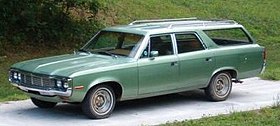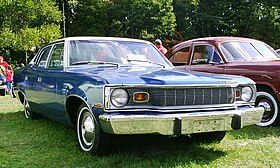AMC Matador
| AMC Matador | |
|---|---|

1976 AMC Matador coupe
|
|
| Overview | |
| Manufacturer | American Motors Corporation |
| Also called |
|
| Production | 1970–1978 |
| Assembly |
|
| Designer | Richard A. Teague |
| Body and chassis | |
| Class |
|
| Layout | FR layout |
| Related | AMC Ambassador |
| Chronology | |
| Predecessor | AMC Rebel |
| Successor |
AMC Concord Eagle Premier |
| First generation | |
|---|---|

1972 AMC Matador station wagon
|
|
| Overview | |
| Model years | 1971–1973 |
| Body and chassis | |
| Body style |
|
| Powertrain | |
| Engine | |
| Transmission | |
| Dimensions | |
| Wheelbase | 118 in (2,997 mm) |
| Length |
|
| Height |
|
| Second generation | |
|---|---|

1975 Matador base model sedan
|
|
| Overview | |
| Model years | 1974–1978 |
| Body and chassis | |
| Body style |
|
| Powertrain | |
| Engine | |
| Transmission |
|
| Dimensions | |
| Wheelbase |
|
| Length |
|
| Height |
|
The AMC Matador is a mid-size car built and marketed by American Motors Corporation (AMC) from 1971 to 1978. The Matador came in two generations: 1971 to 1973, and a major redesign from 1974 to 1978. The second-generation four-door sedan and station wagon models were classified as full-size cars and did not share the distinctive styling featured by the Matador coupe that was introduced in 1974.
Factory-backed AMC Matador hardtops and coupes competed in NASCAR with drivers that included Mark Donohue and Bobby Allison winning several races. The new Matador coupe was featured in The Man with the Golden Gun, a James Bond film released in 1974. Matadors were a popular vehicle for the police, as it outperformed most other police cars. It was also featured in many television shows and movies during the 1970s.
The Matador became AMC's largest automobile following the discontinuation of its flagship, the AMC Ambassador, built on the same platform. Premium trim level "Oleg Cassini" and "Barcelona" versions of the Matador coupe were positioned in the personal luxury car market segment. Matadors were also marketed under the Rambler marque in foreign markets, as well as assembled under license agreements with AMC that included Vehículos Automotores Mexicanos (VAM), as well as built in right-hand-drive versions by Australian Motor Industries (AMI).
The Matador replaced the AMC Rebel, which had been marketed since 1967. With a facelift and a new name, the AMC Matadors were available as a two-door hardtop as well as a four-door sedan and station wagon. The Matador was based on AMC's "senior" automobile platform shared with the full-size Ambassador line.
...
Wikipedia
